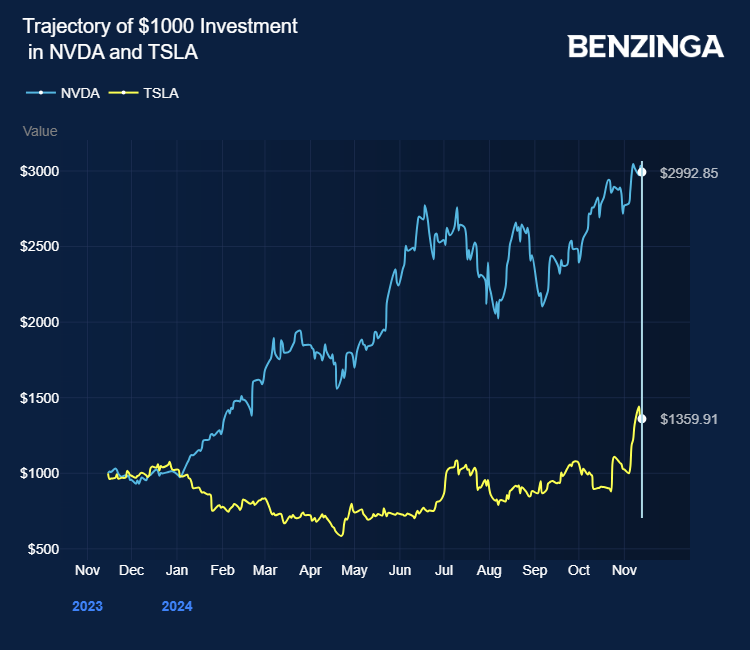Zinger Key Points
- Nvidia plans to launch its Jetson Thor computers for humanoid robots by mid-2025, targeting AI-driven robot enhancements.
- Nvidia's new platform aims to improve robot autonomy, focusing on partnerships with Siemens, Universal Robots, and Tesla.
- Markets are swinging wildly, but for Matt Maley, it's just another opportunity to trade. His clear, simple trade alerts have helped members lock in gains as high as 100% and 450%. Now, you can get his next trade signal—completely free.
Nvidia Corp NVDA is preparing to launch its latest technology for humanoid robots in the first half of 2025 as part of its strategy to enter the fast-evolving robotics industry. The company aims to establish a strong foothold by offering advanced computing solutions tailored for AI-driven robots, the Wall Street Journal cites a senior executive.
The new Jetson Thor computers were introduced earlier this year and are designed to enhance the capabilities of human-like robots.
Also Read: Taiwan Semi Boosts Advanced Chipmaking with Record EUV Expansion, Grabs 56% Global Share
The technology aims to leverage advancements in artificial intelligence, boost robot autonomy, and improve their interactions with people and their environments.
Nvidia’s Jetson Thor marks the latest addition to its Jetson platform, a series of compact, high-performance computers developed for AI applications.
During Nvidia’s annual conference in March, CEO Jensen Huang highlighted the company’s commitment to the robotics sector, demonstrating several robots powered by Nvidia’s chips. Rather than building robots, Nvidia intends to provide the underlying technology, similar to how Google supplies Android for smartphones.
Nvidia aims to cater to a broad, fragmented market of numerous robot manufacturers, contrasting with the smartphone industry, which a few large players dominate.
Deepu Talla, Nvidia’s Vice President of Robotics and Edge Computing, told the WSJ that the company has formed strategic partnerships with industry leaders like Siemens and Universal Robots to integrate its platform into various robotics solutions.
Talla emphasized that Nvidia’s role is to supply the computing platform for robots, while companies like Tesla Inc TSLA lead the development of physical robotic systems.

Tesla’s humanoid robot, Optimus, is set to begin limited production by late 2025, with plans for broader commercial availability by 2026. Nvidia is already providing key technology components to support Tesla’s robotics initiatives.
Nvidia joined forces with Hugging Face to boost robotics innovation using open-source AI technology.
At the Conference for Robot Learning (CoRL) in Munich, Germany, the two companies unveiled a partnership to speed up robotics research by bringing together their open-source communities.
The alliance integrates Hugging Face’s LeRobot AI platform with Nvidia’s AI, Omniverse, and Isaac’s robotics systems, aiming to drive progress in manufacturing, healthcare, and logistics.
Nvidia stock surged 204% year-to-date.
Morgan Stanley’s Joseph Moore noted that Nvidia’s upcoming Blackwell chip launch is driving substantial revenue, potentially contributing $5 billion—$6 billion in the first quarter.
Moore highlights new growth catalysts for Nvidia, including AI PCs, autonomous vehicles, and per-car software licensing revenue.
Nvidia’s Data Center business is expected to lead long-term growth, powered by strong demand for AI and machine learning hardware.
Investors can gain exposure to Nvidia through SPDR S&P 500 SPY and iShares Core S&P 500 ETF IVV.
Price Action: NVDA stock is up 0.80% at $147.45 at the last check Thursday.
Also Read:
Photo via Shutterstock
Edge Rankings
Price Trend
This content was partially produced with the help of AI tools and was reviewed and published by Benzinga editors.
Market News and Data brought to you by Benzinga APIs© 2025 Benzinga.com. Benzinga does not provide investment advice. All rights reserved.
Trade confidently with insights and alerts from analyst ratings, free reports and breaking news that affects the stocks you care about.